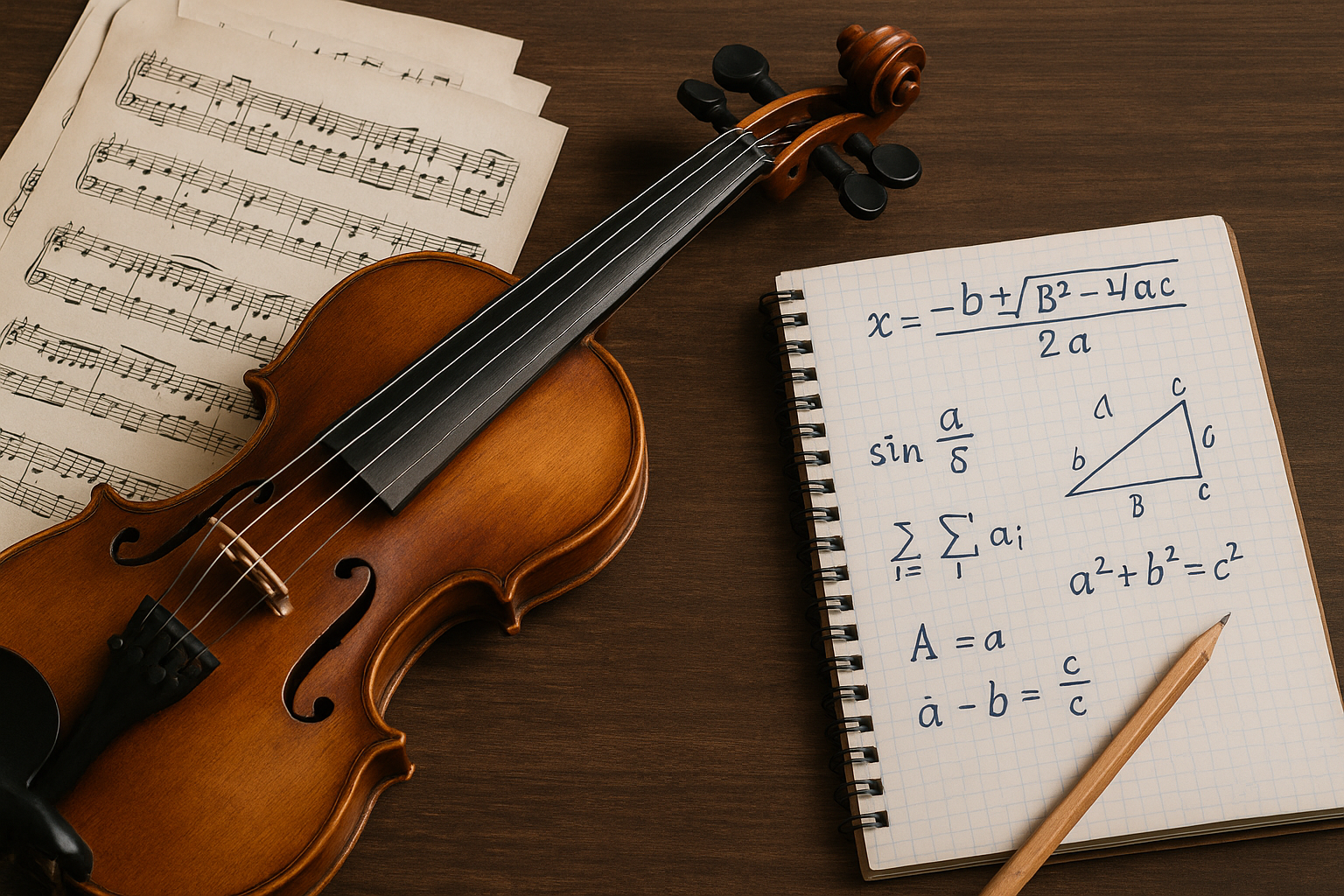At first glance, mathematics and music may seem like two very different worlds. One deals with numbers, formulas, and logic, while the other is often associated with creativity, emotions, and artistic expression. Yet, for centuries, musicians and scientists alike have recognized the deep connection between these two disciplines. Music is not only an art—it is also a form of mathematics in motion.
For beginners learning music, understanding this relationship can make practice more meaningful and even more exciting. You don’t need to be a math genius to enjoy music, but by exploring how math and music intersect, you’ll gain new insight into rhythm, harmony, structure, and creativity.
Why Mathematics Matters in Music
Rhythm and Time
Rhythm is built entirely on mathematical divisions of time. Whole notes, half notes, quarter notes, and eighth notes are fractions of beats. Recognizing this structure helps musicians count and stay in time.
Scales and Intervals
Musical scales are based on ratios between frequencies. For example, the octave is a 2:1 ratio—the higher note vibrates twice as fast as the lower one. These ratios give music its sense of harmony.
Harmony and Chords
Chords are combinations of intervals, and intervals are defined by frequency ratios. The pleasing sound of a major chord, for example, comes from its simple mathematical relationships.
Patterns and Structure
Music often follows patterns, whether in a pop chorus that repeats every 16 bars or a fugue with intricate mathematical design. Recognizing patterns strengthens memory and creativity.
Symmetry and Proportion
From classical sonatas to modern pop songs, many compositions use symmetry and proportion in their form, often mirroring mathematical balance.
A Brief History of Math in Music
- Pythagoras (6th century BCE): Discovered the relationship between string length and pitch, laying the foundation for the science of tuning.
- Medieval and Renaissance eras: Composers used ratios and proportions to organize rhythm and harmony.
- Baroque period: Bach’s fugues and canons show intricate mathematical design.
- 20th century: Modern composers like Schoenberg and Xenakis used mathematical formulas and probability in composition.
Throughout history, math has not limited music—it has expanded it.
How Math Helps Beginners Learn Music
Counting Beats
Math teaches you to divide time, making rhythm clearer. For example, clapping eighth notes while a metronome clicks on quarter notes builds precision.
Understanding Scales
Learning that scales follow step patterns (like whole step–whole step–half step) shows that music follows logical structures.
Practicing with Fractions
Rhythmic exercises using fractions (such as dividing a beat into thirds or fourths) strengthen both math and musical skills.
Composing With Patterns
Beginners can use simple number patterns to create melodies—for example, assigning numbers to notes and building sequences.
Practical Exercises Combining Math and Music
- Fraction Rhythm Exercise
Clap a whole note, then divide into halves, quarters, and eighths. This teaches how beats subdivide mathematically. - Ratio Listening
Play octaves, fifths, and fourths on an instrument. Notice how simple ratios (2:1, 3:2, 4:3) create consonance. - Pattern Building
Use a number sequence like 1-2-3-5 and assign it to scale degrees. Play the resulting melody and experiment with variations. - Symmetry in Composition
Write a short melody and then invert it, creating a mirror image. This introduces the concept of symmetry in music. - Polyrhythm Challenge
Tap one hand in groups of three and the other in groups of two. This mathematical overlap creates complex rhythms found in many world traditions.
The Role of Math in Different Musical Styles
- Classical: Composers used strict forms and proportions.
- Jazz: Improvisation often plays with rhythmic and harmonic patterns rooted in math.
- Rock: Repeated riffs and steady meter rely on numerical structure.
- Electronic: Computer-based music uses algorithms and digital patterns directly tied to math.
- World Music: African drumming and Indian classical music use complex mathematical rhythms passed down through tradition.
Overcoming the Myth: “I’m Bad at Math, So I Can’t Do Music”
Many beginners fear music theory because it looks like math. But remember: you already use math every time you tap your foot to the beat or recognize a repeating pattern. Music turns math into something you can hear and feel, making it more accessible and enjoyable.
The Psychological Connection Between Math and Music
Research shows that learning music strengthens mathematical skills and vice versa. Both require pattern recognition, problem-solving, and abstract thinking. Some studies suggest that students involved in music often perform better in math-related subjects.
How Teachers Use Math in Music Education
Good teachers often link math to music in practical ways:
- Explaining rhythms with fractions.
- Showing the geometry of scales and intervals.
- Using patterns to simplify memorization.
- Encouraging composition through number games.
The Emotional Side of Mathematical Music
Even though math sounds logical and rigid, its application in music creates emotion and beauty. Ratios create harmony, subdivisions create rhythm, and patterns create familiarity. Understanding the math behind the sound doesn’t make it less magical—it makes it more fascinating.
Long-Term Benefits of Exploring Math in Music
- Stronger rhythmic accuracy.
- Clearer understanding of harmony and structure.
- Enhanced creativity through pattern exploration.
- Improved memory by linking concepts logically.
- Greater appreciation for the hidden order in music.
Final Thoughts: Numbers That Sing
At its core, music is both art and science. Mathematics provides the framework, but human creativity fills it with meaning and emotion. You don’t need to solve equations to enjoy music, but by recognizing the patterns, ratios, and structures, you gain new tools to grow as a musician.
The next time you practice, try asking yourself: What numbers are hidden in this music? You may discover that every note is part of a larger pattern—proof that math and music are partners in creating beauty.
